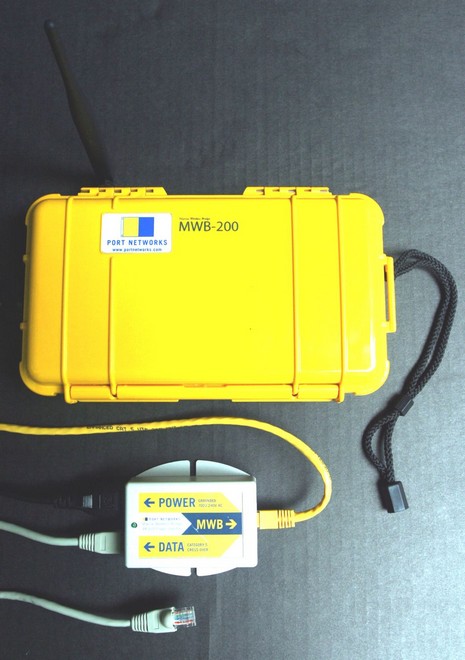Port Networks WiFi bridge, another approach

My photo is none too great, but at least at bigger size you can make out the hardware components. Port Network’s approach to marine WiFi is not a fixed high dB antenna but rather minimizing the distance between an independent, well amplified WiFi radio and its relatively small antenna. The wiring is further simplified by ‘injecting’ power into the 25’ Ethernet cable. The result: a waterproof, portable WiFi bridge that you deploy on deck when you anchor or tie up. I’ve tried it now in Boston and around Camden Harbor and can say with assurance that it locks in way more WiFi signals than my little Linksys PCMCIA card. It finds available access points automatically, too, though you can use a browser to get into its extensive software, below, and survey what APs are in sight.
The screen shot, incidently, shows how two commercial providers, Abacus Technology and Mesh-Air, have blanketed Camden Harbor with WiFi, and right now the latter is giving it away. Thank you, Mesh-Air. I could barely get two of those APs with my regular card, but I must say I’m curious how this thing would work with a 9dB antenna. On the other hand, it would quite handy as is in several hotels and other situations I’ve been in over the last year. (Here’s a PDF describing the MWB-200 in more detail, and here’s its online store blurb).

PS, 6/15, Port Networks comments:
To answer your speculation about how it would perform with a 9dB antenna: great, when it worked at all. Here’s why…
Omni antennas like these are passive devices, achieving their gain by focusing the signal passing through them. They redirect signal that would go up and down, using it to push farther out to each side. (Imagine someone taking a ball of dough and squeezing it down into a pancake. The radius of the pancake is considerably larger than the radius of the ball, and that’s the gain.) The tradeoff for higher gain is less coverage — relatively little signal is being sent above and below that horizontal beam. With a very high-gain antenna, the beam is so flat that alignment becomes critical. If the antennas on either end aren’t in exactly the same plane, then they won’t even communicate. We chose a 5.5dB antenna to provide a balance between gain and a wider beam. A 9dB antenna would provide twice as much gain, but if the boat rolled, or the antenna wasn’t at 90 degrees to the path between the two radios, etc., the signal might be lost entirely.
P.S. I should mention that the above applies primarily to omni antennas. Another way to get gain without giving up too much beamwidth is to use a directional antenna, akin to the reflector inside a flashlight. We will be introducing a second model with a directional antenna shortly. By virtue of its directionality, it will have to be aimed, and you’ll therefore need to know the location of the access point to which you want to connect, but for those people who are in the situation of trying to connect a long way within their own marina, it will offer twice the gain of our current model.













I used a patch antenna that has about a 90 degree range of coverage and 9dB gain. It seems to work for the 450′ I’ve needed to cover at my friend’s marina. It is connected to a Linksys WiFi bridge, which is wired into the ethernet network on his boat.
The patch antenna seems to be a fairly good compromise as it can handle a bit of heeling or swinging on the mooring.
While interesting, I would need to see range and signal quality comparisons before plunking dow $349. I had been using a Buffalo USB Airstation which I hung off a clothesline acoss the stern. After being knocked down by my carelessness over 50 times, it finally had an LED break off the PCB and died. Not bad for $42 and it got an excellent signal at a range of 60 yards from a weird omni antenna installed back near the marina building.
Since a replacement was not available locally
(New B 2.0 Adapter for $79. It’s superb and located inside the cabin. 1/2 the size of a cigarette pack.
The part that was chopped off my previous message referred to the Netgear RangeMax Wireless USB 2.0 Adapter Model WPN111.
Interesting… for those smaller boats and/or those that don’t want/need something permanently installed.
Understand they also have what they call custom bridge systems (bridge/router capable) that would be more permanently installed.
From my experience. Need more than 50 foot of cable though on most bigger yachts.
—
Alan Spicer
http://www.marinetelecom.net